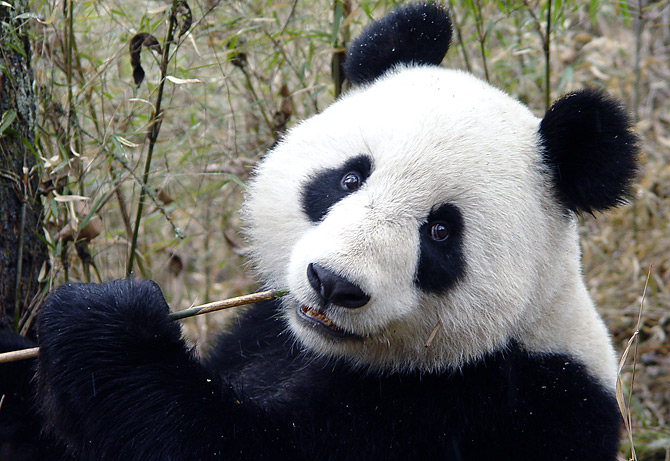|
First Off: General Facts
* Family Ursidae- the bear family
* Native to central-western and southwestern China
* distributed in a few mountain ranges- central China, Sichuan, Shaanxi, and Gansu provinces
* Once lived in lowland areas
* Farming, forest clearing, and other development now restrict giant pandas to the mountains* Live in broadleaf and coniferous
forests with dense understory of bamboo, elevations between 5,000-10,000 feet
* Diet consists of 99% bamboo
* Eats bamboo almost 12 hours a day
* Sleeps for the rest of the day
* oddly belongs to order Carnivora
* If available eats honey, eggs, fish, yams, shrub leaves, oranges, and bananas
* Thick wooly coat keeps it warm in its cool forest
* Large molar teeth and strong jaws for crushing bamboo
* Highly endangered
* China has 239 giant pandas in captivity and 27 living outside the country
* Estimated 1,590 pandas living in the wild
* Adults measure around 1.5 m long and around 75 cm tall, shoulder length
* Males 10-20% larger than females
* Males weigh up to 115 kg(253 lbs.)
* Females occasionally weigh up to 100kg(220 lbs.)
* Adults generally solitary
* Communicate through periodically through scent marks, calls, and occasional meetings
* Has a paw with a "thumb" and five fingers
* Their "thumb" is a modified sesamoid bone for easier bamboo holding
* 2nd largest tail in bear family, 4-6 in.
* Live up to 20-30 yrs. in captivity
* Cub is about 150 g and the size of a stick of butter
* Listed as endangered in the World Conservation Union's (IUCN's) Red List of Threatened Animals
An adult eating bamboo

Panda Poaching(oh no!)
Pandas have been targets for poachers since ancient times. And by foreigners since they were introduced to the West, but
were unable to hunt them in the 1930's caused by the Second Sino-Japanese War and the Chinese Civil War.
But for the locals pandas provided them with soft furs. This also lead illegal poaching for the black market after the
Chinese economic reform. During this time panda skins were in high demand.
There were a number of cases of poaching in the 1980's and 1990's but this has declined due to strict laws of conserving
pandas. However people hunting for other animals in the panda habitat also pose a threat. Traps set for deers or other bears
accidentally kill Giant Pandas.
Before revising the Criminal Law of China in 1997, a person proven guilty for killing a Giant Panda could receive the
death penalty, and some panda poachers were in fact executed. The most severe punishment a person can get from panda murder
today is over 10 years in prison.
|
 |
|

